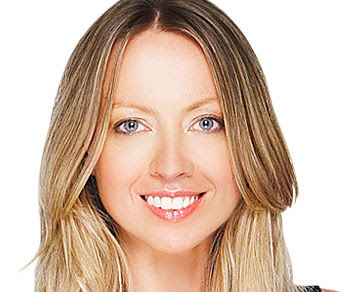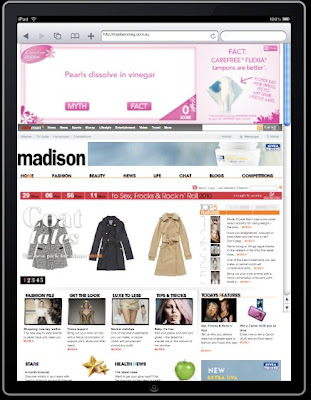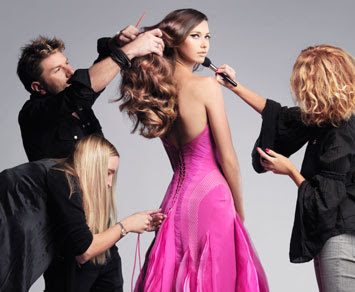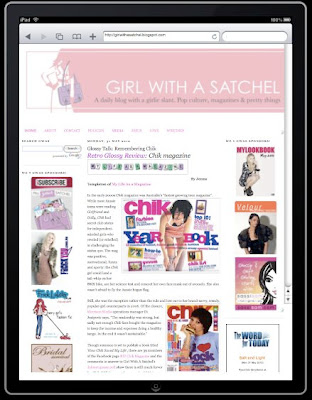By Katrina Lawrence, contributing
 beauty editor, Madison; iGeek
beauty editor, Madison; iGeekSo there I was, super-early Friday morning, lining up in a queue that snaked from Apple Sydney all the way around the block. Waiting, of course, to get my mitts on the much-hyped iPad. Surprised? Well, don’t be fooled by my beauty editor exterior, I have an inner geek and she sure came out last Friday.
By Friday night, I was ensconced on the couch with my brand new shiny toy and a big glass of red and – sad as this may sound to some of you – had the most fabulous time I've had since my Stella McCartney Paris shopping frenzy.
Being a magazine girl – both junkie and employee – I just can’t help but feel that this is the way forward. Now, I love glossy paper. I still can’t help stroking my stories and shoots when they appear in print (the other day, when I came across my first-ever magazine tear sheets – the fashion-trend back page for the much-missed Australian Elle – I couldn’t help but feel nostalgic). But we can’t ignore the fact that times are changing. And I think we’ve all been waiting for something like the iPad to really propel us forward.
So to the iPad… and, specifically, to e-mags.
The first app I downloaded was Wired magazine.
 I’m not a Wired reader by any stretch. I don’t even really get what it’s about. But I bought the June issue (for $5.99 via iTunes) because I’d read that Wired has been making a huge effort to create an iPad-friendly version of their print mag. And, boy, have they ever. You can press buttons to hear music clips or see film snippets. Or, geniously, bring up revolving captions or photos.
I’m not a Wired reader by any stretch. I don’t even really get what it’s about. But I bought the June issue (for $5.99 via iTunes) because I’d read that Wired has been making a huge effort to create an iPad-friendly version of their print mag. And, boy, have they ever. You can press buttons to hear music clips or see film snippets. Or, geniously, bring up revolving captions or photos.Layouts can be less cluttered, which art directors will be ecstatic about (advertisers will also adore how their ads can link to TVCs and websites, or become virtual catalogues). It also means that stories that are too long for their print boundaries now have a new way of fitting into the digital version. This is great news for someone like me, who tends to over-write (what can I say, I like words) but maybe not such joyous news for the production/art peeps, who do need to go home and sleep from time to time.
That said, you do need to have some limits when it comes to quality content. A mag needs to be an edit after all, not a bottomless pit of information. But the fact that there is now an option for seamlessly slipping in some extra boxes here and there (and still allow art to have the nice white space they so love) is pretty fantastic.
It will be fascinating to see how far e-mags
 go in the future. Will they remain a cutely enhanced version of their print siblings? Or will they morph into something akin to a television show? Because, really, if you went behind the scenes with the fashion and features teams during the making of one issue, and could show these clips throughout an e-mag (imagine a fashion workshop coming alive), you’d have a pretty nifty reality-meets-info show.
go in the future. Will they remain a cutely enhanced version of their print siblings? Or will they morph into something akin to a television show? Because, really, if you went behind the scenes with the fashion and features teams during the making of one issue, and could show these clips throughout an e-mag (imagine a fashion workshop coming alive), you’d have a pretty nifty reality-meets-info show.To see where fashion and lifestyle mags may go with the iPad, watch out for the US Vogue magazine app, apparently launching soon (the Vanity Fair one is available now but annoyingly only for US iTunes customers).
In the meantime, some mags are available as straight soft-copy replicas. If you download the Zinio Magazine Newsstand app (free on iTunes), you can subscribe to the digital versions of a number of international mags. - I bought French Vogue, US Elle and US Harper’s Bazaar. But here’s the best bit: a year’s sub cost me $23.99, $8.65 and $8.65 respectively. I know! Crazy right? (O and French Glamour are next on my to-buy list). That’s a year’s worth of issues for basically the cost of one issue on the stands here, which you have to wait for. June Harper’s is due out tomorrow and I’ll wake up to it.
As for reading the mags digitally, I’m getting used to it. I love that you can zoom in on copy, and on details such Kate Moss’s fabulous Vogue cover makeup (Marilyn-esque liquid liner and red lipstick). But I hate that you can’t save pages or copy them to somewhere (I’m forever ripping out pages I love or at least tagging them). Still, it’s something I can live with until these mags have their own apps and features such as bookmarking.
I think that reading on the iPad in general is going to be a work in progress for a long while. Apple’s iBooks hardly has anything to read beyond the classics (talks are apparently still being held with publishers), although Borders has a bookstore app with an impressive selection (I just bought Nancy Mitford’s reprinted Wigs on the Green, which I started reading last night with the white-on-black night-light switched on).
I don’t think the iPad signs the death knell for lush coffee-table-type books. But publishers of novels and magazines should look out. Or else move with the times. With seatbelts on! Because I have the feeling it’s going to be one heck of a ride. And I don’t know about you, but I can’t wait to be on it.
Images: ACP 30 Days of Fashion & Beauty
Some GWAS reader thoughts (generally poo-pooing the iPad*). You are a witty bunch.
"It's hard saying no, especially given how
 obsessed I am with my mac and iphone - they'd love a buddy - but there is something to be said for delayed gratification. Oui?" - Rebecca
obsessed I am with my mac and iphone - they'd love a buddy - but there is something to be said for delayed gratification. Oui?" - Rebecca"I work in publishing and am terrified that one day my grandchildren won’t be able to go to a library and find solace within the pages of a book like I can. Many new technical advances, while oh so convenient, make me a little bit sad." - Velvet
"I’m an old-fashioned type of girl. I don’t just fall for the new guy in town. I want him to seduce me, to show me how much he loves me. Before I break up with my Nano and Kindle, I’m going to wait until IPad can show me that he handle my data without sending me broke and he is an example of hardware that remains stable." - Carolyn
"I love my books and magazines too much - the feel, the smell and the way they look on my bookcase, something that an iPad or any e-reader can never replicate. " - Wendy
"As a trying-to-recover workaholic, I don’t need any tools to make it easier to work from home/the train/my parents farm or anywhere other than the office. An iPad, I fear, is enough to tip the precarious work-life balance a little too far in the work direction. I’m pretty sure cosying up to an iPad wouldn’t be the same as cosying up to UK Vogue in bed like I enjoyed last night, nor would it have the same effect as the Hermes-orange row of Penguin classics on my book shelf." - Susan
"With winter rearing its rather soggy, damp head, curling up with a good book has never felt so good. Curling up with an iPad doesn't have the same ring or feel to it. In a flash, you switch it off, and the book or story has gone, disappeared. Give me a tangible, timeless, 'old-fashioned' book or magazine or newspaper any old day." - Laura
*Of course, iPad = great for the "blogazine", as much of a paper-head as I am, too. Thank you, everyone for adding your two cents!
Yours truly,
Girl With a Satchel









































